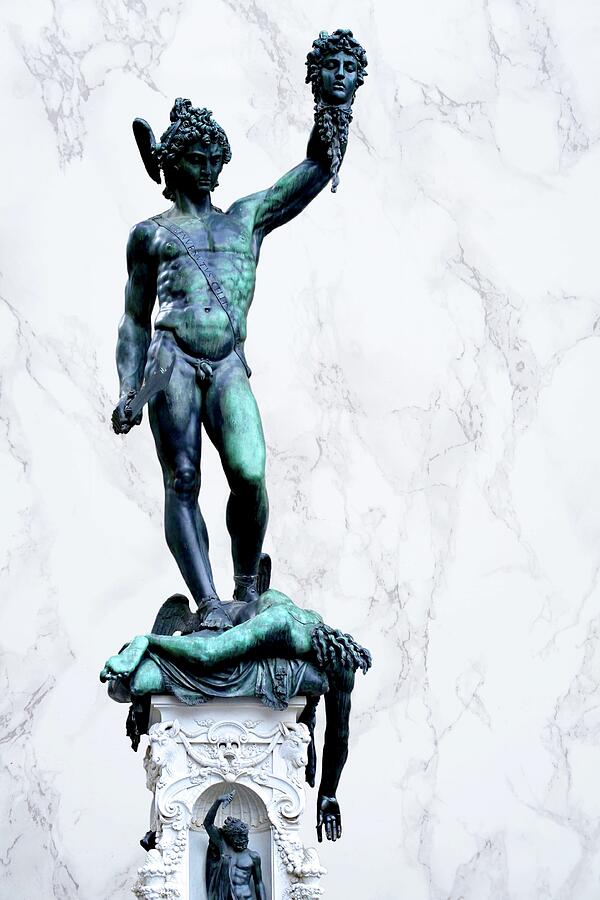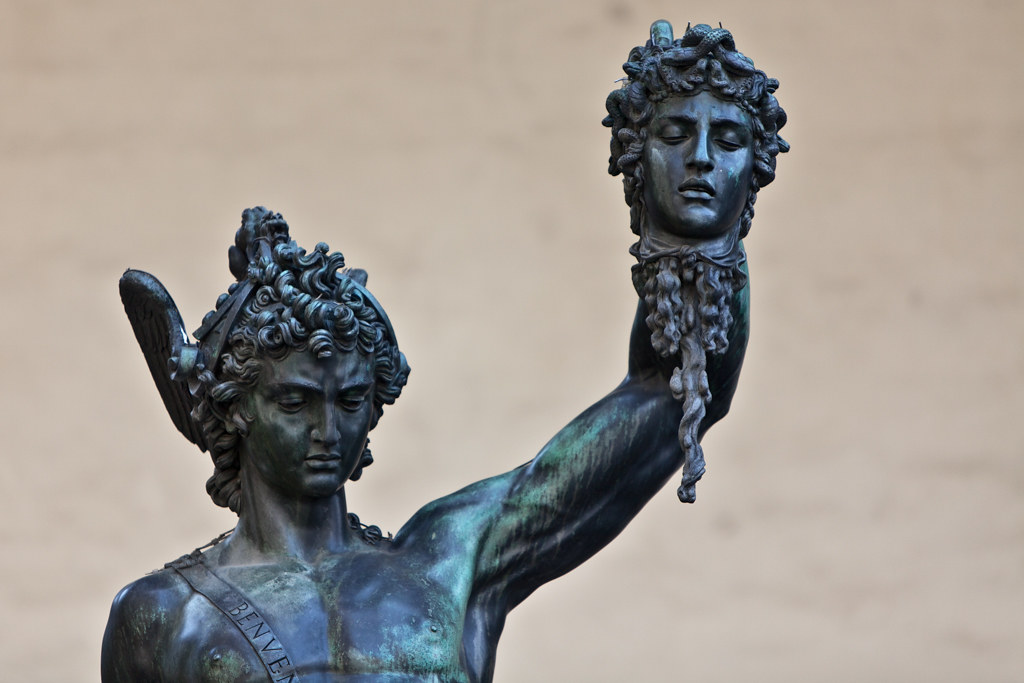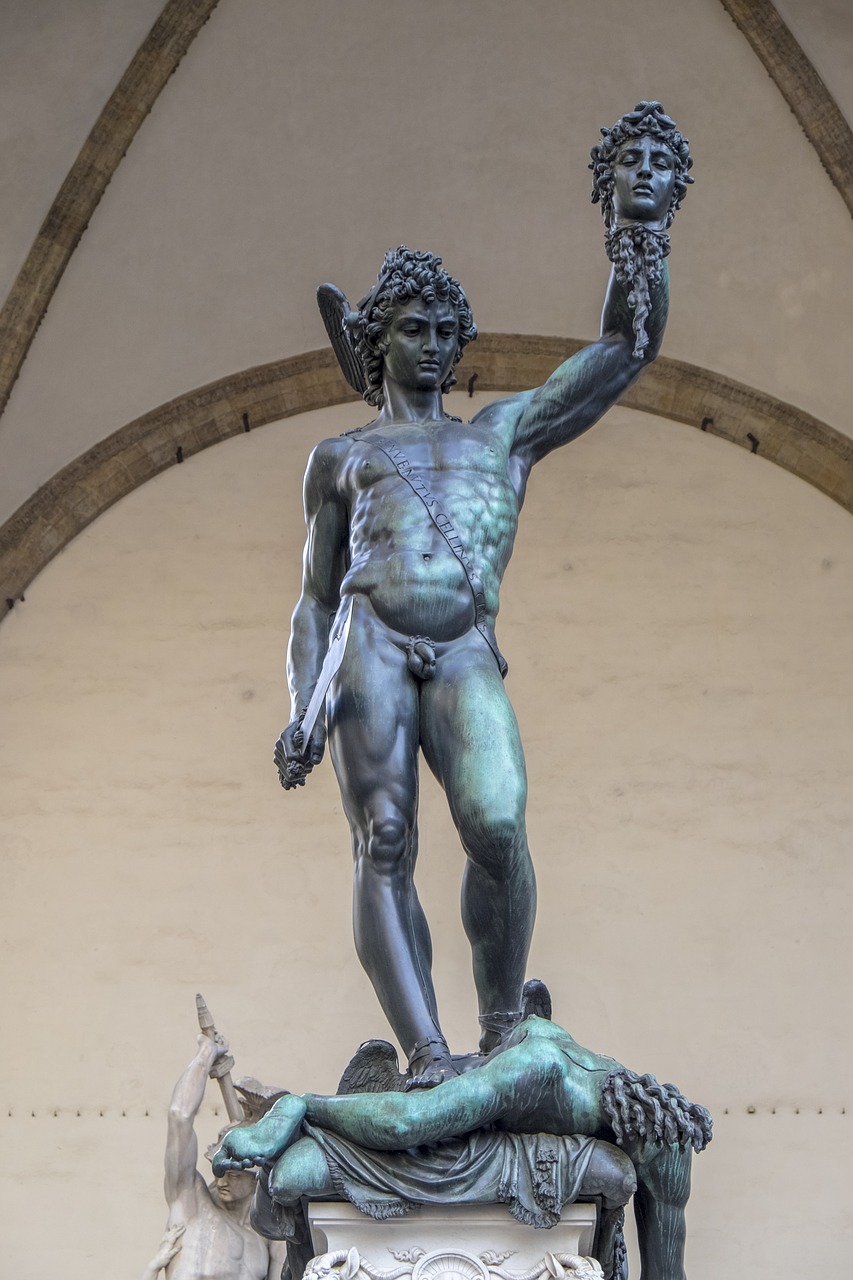
Perseus holding the head of Medusa by Benvenuto Cellini, Florence, Italy. Photograph by Joe
Benvenuto Cellini (/ ˌ b ɛ n v ə ˈ nj uː t oʊ tʃ ɪ ˈ l iː n i, tʃ ɛ ˈ-/, Italian: [beɱveˈnuːto tʃelˈliːni]; 3 November 1500 - 13 February 1571) was an Italian goldsmith, sculptor, and author.His best-known extant works include the Cellini Salt Cellar, the sculpture of Perseus with the Head of Medusa, and his autobiography, which has been described as "one of the most.

Perseus with the Head of Medusa Piazza della Signoria ♦ Firenze, Italy Siena Toscana, Places
Perseus with the Head of Medusa is the famous statue by Benvenuto Cellini, found in Florence in piazza della Signoria, under the Loggia dei Lanzi, and one of the most important examples of Italian Mannerist sculpture. Cellini, one of the greatest goldsmiths of the Renaissance, was commissioned by Cosimo I de' Medici to sculpt this work in 1545.

Head of Medusa, Florence Perseus and medusa, Medusa art, Statue
Marble. The Metropolitan Museum of Art, New York, Fletcher Fund, 1967 (67.110.1). Here, the mythological hero Perseus triumphantly presents his trophy, Medusa's head, to the world. Through this dynamic pose, Canova draws our attention to the sweep of Perseus's idealized body, which is framed by a drape falling from his left arm.

Perseus and Medusa, Florence The statue of Perseus slaying… Flickr
Benvenuto Cellini, Perseus with the Head of Medusa, c. 1554, bronze (Loggia dei Lanzi, Piazza della Signoria, Florence). Created by Beth Harris and Steven Zucker. Questions Tips & Thanks Want to join the conversation? Sort by: Top Voted Tanner Perkin 10 years ago

Perseus Holding the Head of Medusa.Ο Περσέας κρατά το κεφάλι της Μέδουσας. Statue, Greek
1545-54. Bronze, height 550 cm. Loggia dei Lanzi, Florence. Cellini's work in bronze is much more interesting than his work in marble, and this is clearly demonstrated by Perseus with the Head of Medusa. His posthumous fame is largely linked to this statue and to the passionate description of its casting that appears in Vasari's Vita; this.

Perseus and the Head of Medusa A Very Florentine Story
Benvenuto Cellini's bronze sculpture of Perseus and Medusa (1545-54), which stands under the left arch of the Loggia dei Lanzi, is one of the most beautiful works of art in Florence. The statue was commissioned by Duke Cosimo I de' Medici (r. 1537-74) and unveiled to the public on April 27th 1554. It illustrates the story of the Greek hero Perseus, who slew the monstrous Gorgon Medusa, whose.

Perseus by Cellini Loggia dei Lanzi Statue, Perseus and medusa, Greek mythology
Coordinates: 43.7692°N 11.2558°E Perseus with the Head of Medusa by Benvenuto Cellini Perseus with the Head of Medusa, in the Loggia dei Lanzi, Florence Perseus with the Head of Medusa is a bronze sculpture made by Benvenuto Cellini in the period 1545-1554.

Perseus with the Head of Medusa Florence, Italy Thomas Leplus Flickr
Cellini's Perseus and Medusa at the Loggia dei Lanzi, 1554 @ Piazza della Signoria, Florence, Italy. Ref. (a-63). The sculpture is made of solid bronze. And some pewter, including Cellini's platters, dishes, and bowls which he threw in during the casting process when it looked like there wouldn't be enough molten metal to fill his mould.

Perseus & Medusa (detail), Benvenuto Cellini, 1554, Florentine, Mannerism, Late Renaissance
Benvenuto Cellini, Perseus with the Head of Medusa, 1545-1554, Piazza della Signora, Florence, Italy. Villa Campestri. Benvenuto Cellini's Perseus and the Head of Medusa is a sculpture that is commonly overlooked. In fact, it could be the most regularly overlooked work of art in the world.

Perseus,medusa,firenze,sculpture,italy free image from
Cellini's Perseus with the Head of Medusa dominates the left bay of this relatively small structure. It's full of amazing sculptures created by some of the most renowned artists in history. Loggia dei Lanzi / Sailko / Wiki Commons. 8. There are a large number of similar statues all around the world.

Bronze Perseus & Medusa in Piazza della Signoria. Florence, Italy Rae 12/28/13 Cinque Terre
The statuary groups of Piazza della Signoria, in Florence, offer to us a fascinating insight on the way of thinking of the people who commissioned and created them during the Renaissance , and also how this way of thinking evolved over more than a century of time. Among these pieces, the "Perseus and Medusa " by Cellini (Fig. 49.1) is perhaps the one which brings the greatest wealth of.

Cellinis statue of Perseus with the head of Medusa. Florence, Italy Photograph by David Lyons
Medusa With the Head of Perseus is a work of art that turns the old Greek mythological tale on its head, so to speak. It was sculpted by Italian artist Luciano Garbati who in his youth, would often see Benvenuto Cellini's Medusa and Perseus sculpture at the Loggia Dei Lanzi in Florence, close to his hometown.

Perseus With The Head Of Medusa Florence Italy HighRes Stock Photo Getty Images
Plaster cast, painted plaster, after the original bronze of Perseus with the Head of Medusa, by Benvenuto Cellini in Padua, about 1545 and now in the Museo Nazionale (Bargello), Florence, Italy. Cast in about 1882 in Berlin, Germany.

Pin on Medusa
Benvenuto Cellini, Perseus with the Head of Medusa by Dr. Beth Harris and Dr. David Drogin Benvenuto Cellini, Perseus with the Head of Medusa, c. 1554, bronze (Loggia dei Lanzi, Piazza della Signoria, Florence) More Smarthistory images…

Cellini Perseus with the head of Medusa. Statue was in the Piazza della Signoria in Florence
The exhibition features replicas of the five bronze statues, including Perseus with the Head of Medusa (1552), created by Benvenuto Cellini (Italian, 1500-71) for the Piazza della Signoria in.

Perseus with the Head of Medusa Sculpture by Benvenuto Cellini Florence, Italy vsco
Perseus, in Greek mythology, the slayer of the Gorgon Medusa and the rescuer of Andromeda from a sea monster. Perseus was the son of Zeus and Danaë, the daughter of Acrisius of Argos. As an infant he was cast into the sea in a chest with his mother by Acrisius, to whom it had been prophesied that he would be killed by his grandson.